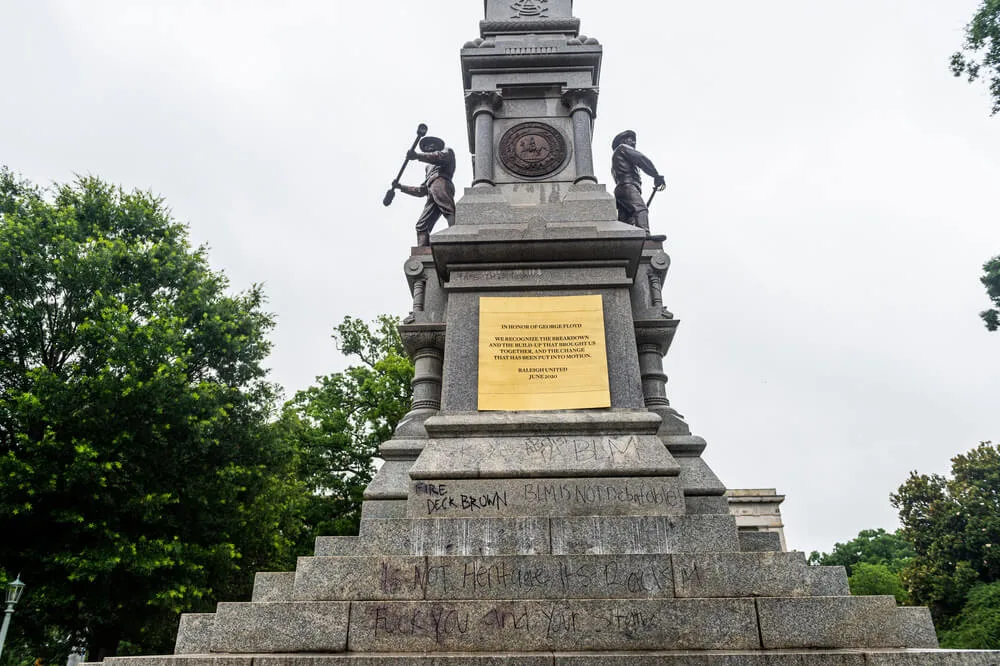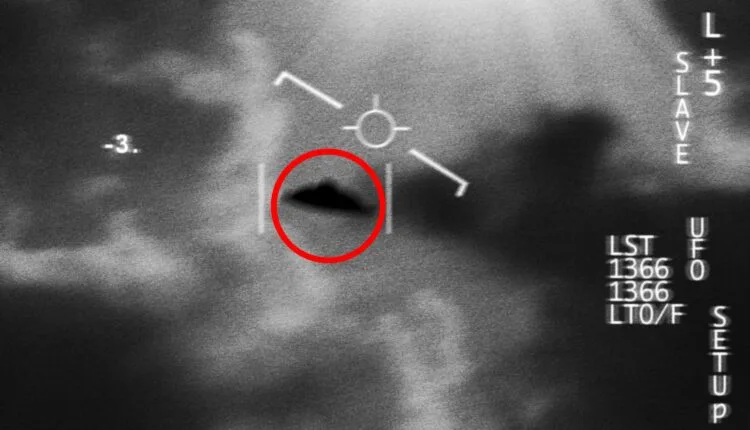
A plaque in honor of George Floyd was added to the Confederate monument on the Capitol grounds during a protest. (Image via Shutterstock)
While other North Carolina cities concede Jim Crow era monuments must go, Graham stands firm.
Just after sunset on June 29th, a woman parked her minivan near courthouse square in downtown Graham and exited carrying a large poster.
Standing near the monument of a Confederate soldier stationed outside the Alamance County courthouse like a sentinel, she raised the handwritten sign above her head that read: “There are no white people in the Bible.”
Not long after, Graham Police Sgt. R.S. King arrived and demanded she move or be arrested, according to a News & Observer report.
The protester placed the sign on her windshield and leaned against the hood of her vehicle, which failed to satisfy King. When he returned about 15 minutes later, he told the protester to put the sign in her car, or she would be arrested.
“I know what you’re doing and you know what you’re doing,” said King. “If you want a court date, I’ll be glad to abide by it. That’s your second warning. When I come back, the third one will be ‘failure to disperse’ and then anybody standing out here (is) going to get [arrested].”
The protester lingered a while longer but left before King returned for a third time.
Resisting calls for change
In the wake of the killing of George Floyd at the hands of Minneapolis police, protests have erupted across the country calling for an end to police violence and racial injustice. As a result, many places have removed Confederate monuments from public spaces, noting that they glorify the Confederacy, a rogue nation formed to preserve slavery, and were erected decades after the Civil War during the Jim Crow era to intimidate Black people.
But Graham and Alamance County are having none of that kind of soul searching. Instead, they have taken stiff measures to protect its Confederate monument and stifle dissent.
Graham declared a state of emergency and enacted curfews after protests began. Alamance County Sheriff Terry Johnson, no stranger to controversy over racial issues, took to Facebook to announce that protest permits would not be granted for the foreseeable future. He added that anyone who attempts to protest without a permit will be arrested.
When asked for comment, Johnson declined through his spokesperson. Public Information Officer Byron Tucker said that while the Sheriff’s Office disseminated the information, it plays no role in the permitting process.
First Amendment violations
Graham officials were acting under authority of the city ordinance Sec. 18-172, which defines group demonstrations as “any assembly together or concert of action between two or more persons for the purpose of protesting any matter or making known any position or thought of the group or of attracting attention thereto.”
The broad definition makes anyone with a sign sitting or standing near the monument in violation, unless their permit was approved 24 hours in advance.
Related: A Renewed Push to Remove NC’s Remaining 109 Confederate Monuments
The American Civil Liberties Union of North Carolina called the combination of the emergency order, restrictive ordinance, and refusal to grant permits a “grossly overreaching attempt to broadly and indefinitely suppress all speech and assembly” that amounts to a “complete ban on protest and lawfully protected speech.”
The ACLU, the Lawyers’ Committee for Civil Rights, and the Lockamy Law firm filed suit July 3 in federal court on behalf of the Alamance NAACP and eight individual plaintiffs, arguing that the ordinance violated demonstrators’ First and Fourteenth Amendments rights.
The complaint names county and city officials as defendants.
“There seems to have been a fair bit of collaboration between those two governments to enforce the Graham city ordinance but also to restrict access to the monument and the area around the courthouse,” said North Carolina ACLU Legal Director Kristi Grauke.
“None of Defendant [Graham Mayor Jerry] Peterman’s orders were justified by any actual state of emergency or imminent threat to public health or safety,” the complaint alleges. “They were instead motivated by the Defendants’ desire to prevent individuals and groups, including Plaintiffs, from protesting the Confederate monument, institutionalized racism and police violence against Black individuals and communities in Graham’s town square.”
Statue went up during Jim Crow
The statue at the northwest corner of court square is particularly offensive to many of the county’s Black residents for a number of reasons. The 30-foot monument was erected in 1914 on the spot the Ku Klux Klan lynched Wyatt Outlaw, Graham’s first Black town commissioner.
In 1870, the mob dragged Outlaw from his home, hung him from a tree, and left his body there with a note as a warning to those who might interfere: “Beware, ye guilty, both black and white.”
The Graham chapter of the United Daughters of the Confederacy — which paid for and dedicated the statue — left no doubt about their motivations at the time.
Confederate veteran and Alamance County KKK founder Jacob A. Long told the audience in 1914 that they “have a common interest: to recall the achievements of the great and good of our own race and blood.”
On June 25th, close to 200 black-clad protesters walked through downtown Graham in silent opposition to the statue. Following the crackdown and threats of arrest, protesters have been more sparse but say they have encountered police who either arrested or threatened to arrest them for “resisting, delaying, or obstructing” an officer and “failure to disperse.”
Local protesters complain that police have engaged in disparate policing — aggressively questioning and threatening people they suspect might protest and telling them that they aren’t allowed to carry signs, while letting armed, neo-Confederates with Confederate flags gather without consequence.
A federal judge steps in
Citing the risk of deadly violence, Alamance County Manager Bryan Hagood in late June called for the monument to be relocated. Grahan Mayor Ian Baltutis and dozens of Alamance County officials, including Mebane Mayor Ed Hooks and Elon University President Connie Book wrote a letter to the Alamance County Board of Commissioners asking for its removal, saying the statue represents an ideology incompatible with equality.
Despite increased pressure, the county board has refused to take up such measures.
“There’s nothing to vote on, because it’s illegal to move it,” Chairwoman Amy Scott Galey said, according to the N&O.
County commissioners insist they don’t have the legal authority to move the memorial because of a 2015 state law passed after other southern states began removing Confederate monuments following the murders of nine Black church goers at Charleston’s Emanuel African Methodist Episcopal Church by white supremacist Dylan Roof. The 2015 law prevents “removing, relocating, or altering monuments, memorials, plaques and other markers that are on public property without permission from the N.C. Historical Commission.”
However, that same law also contains a clause that says “an object of remembrance may be relocated if it poses a threat to public safety because of an unsafe or dangerous condition.” Several counties and municipalities have relied on that section to rid public spaces of Confederate hagiography.
Last November, Chatham county commissioners removed the 1907 Pittsboro monument that stood in front of the courthouse “to protect the health and safety of the public and their property.”
Granville County took down the monument in front of the Richard Thornton Library in Oxford, citing a “credible threat.” Wilmington quietly removed the Confederate Memorial and the George Davis Statue from its downtown, calling them a “threat to public safety.”
The Anson County Commission voted to move the statue of a Confederate soldier outside the Anson County courthouse to private property. And Gov. Roy Cooper ordered Confederate statues taken down from the capitol grounds “to protect public safety.”
Asserting that Graham’s anti-protest ordinance mirrors a Greenville law the U.S. Supreme Court struck down more than 50 years ago, the ACLU has already notched an intermediate victory.
The Middle District Court in Greensboro issued a temporary restraining order barring defendants from enforcing the city ordinance. The city has agreed to abide by the ruling.
“I think they recognize that our arguments have merit and that they understand there are problems with the Graham city ordinance as currently written,” says Grauke. “That’s why they agreed to the temporary restraining order.”
The plaintiffs will return to court on July 20 for another hearing to make the injunction permanent. In the meantime, Graham instituted another state of emergency on Friday.
[Editor’s Note: A previous version of this story did not properly attribute quotes from Graham Police Sgt. R.S. King and Alamance County Chairwoman Amy Scott Galey.]
Politics

Op-ed: Michele Morrow poses a huge threat to NC public schools
Students with disabilities would particularly suffer if Michele Morrow were to become the state Superintendent of Public Instruction, Susan Book...

Biden makes 4 million more workers eligible for overtime pay
The Biden administration announced a new rule Tuesday to expand overtime pay for around 4 million lower-paid salaried employees nationwide. The...
Local News

The 5 most believable UFO sightings ever reported in North Carolina
Read about five alien encounters that may forever remain unexplained. When you think of the most common places where you might hear a UFO sighting...

Good News Friday: It’s a good day to be a fan of the NC State Wolfpack
The men's and women's teams will compete for a national championship in college basketball this weekend. Plus: How to watch the solar eclipse, and...




